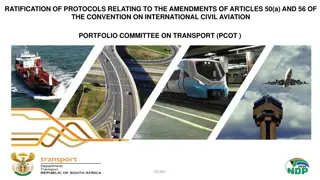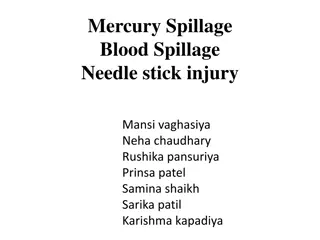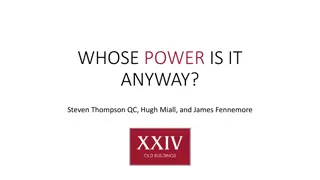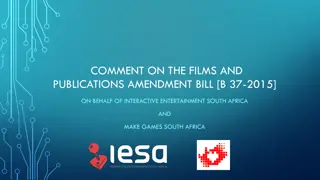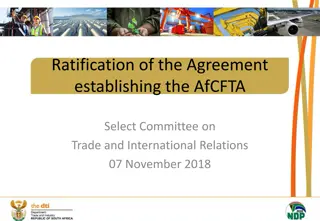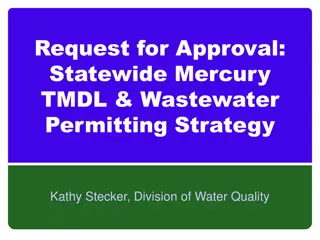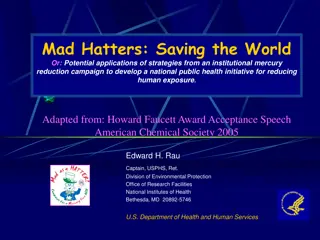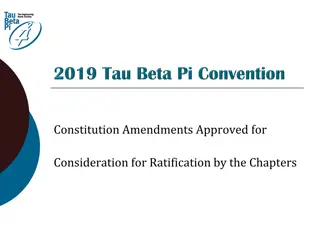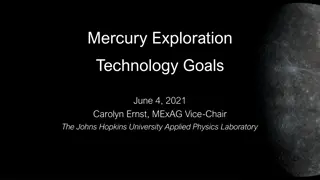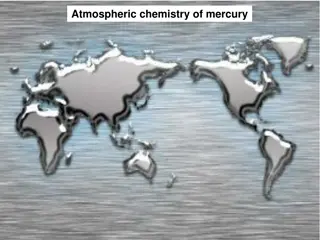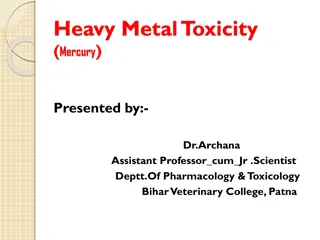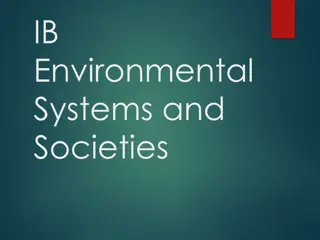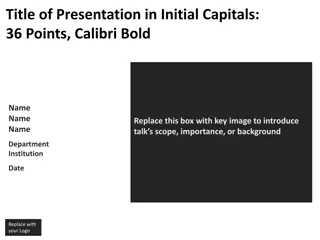South Africa's Ratification of the Minamata Convention on Mercury
South Africa is seeking Parliament's approval to ratify the Minamata Convention on Mercury, which aims to reduce mercury emissions globally. Mercury, a toxic heavy metal, poses significant health and environmental risks through various human and natural activities. The Convention offers financial and technical assistance to support developing countries in meeting their obligations. Ratifying the Convention will enable South Africa to access these benefits and contribute to global efforts in addressing mercury pollution.
Download Presentation

Please find below an Image/Link to download the presentation.
The content on the website is provided AS IS for your information and personal use only. It may not be sold, licensed, or shared on other websites without obtaining consent from the author.If you encounter any issues during the download, it is possible that the publisher has removed the file from their server.
You are allowed to download the files provided on this website for personal or commercial use, subject to the condition that they are used lawfully. All files are the property of their respective owners.
The content on the website is provided AS IS for your information and personal use only. It may not be sold, licensed, or shared on other websites without obtaining consent from the author.
E N D
Presentation Transcript
SECRET SOUTH AFRICA S RATIFICATION OF THE MINAMATA CONVENTION ON MERCURY PORTFOLIO COMMITTEE JUNE 2018 SECRET 1
SECRET PURPOSE To request Parliament to approve South Africa s proposed ratification Convention on Mercury. of the Minamata SECRET 2
SECRET DEFINITION OF MERCURY Mercury is a naturally occurring heavy metal which can cause toxic effects on humans and the environment; It is released through natural processes like volcanic and geothermal activities, or through human processes; Man made mercury emissions primarily come from gold mining using mercury, and combustion of coal, especially coal fired power stations; Human activities continue to increase the mercury in the air, oceans, fresh water and soil, creating a global threat to human and environmental health; Mercury can travel globally through oceans and the atmosphere, and cycles through these processes for years, or even decades; It accumulates in ecosystems and food chains, particularly fish, and is passed on to larger animals and humans who eat those foods; Health effects include significant damage to the nervous (IQ), immune and digestive systems; lungs and kidneys; Chronic or acute exposure can cause neurological and behavioural disorders, and can be fatal. SECRET 3
SECRET BACKGROUND TO THE MINAMATA CONVENTION The Mercury Minamata Convention text was finalised in January 2013, adopted in October 2013; Convention entered into force on 16 August 2017; aims to reduce mercury anthropogenic emissions and releases; South Africa (SA) signed the Convention in October 2013, and intends to ratify it; In 2012 DEA undertook a mercury inventory using UNEP Toolkit Level 1: several sectors emit huge volumes of mercury: coal combustion, cement production, oil and gas production, waste incineration, dental amalgam, primary metal production, etc. In 2016 DEA embarked on developing a detailed inventory using UNEP Toolkit Level 2; has the cost-benefit analysis and the socio-economic implications of SA ratifying the Convention. 4 SECRET
SECRET REASONS WHY SA SHOULD CONSIDER RATIFYING THE MINAMATA CONVENTION (1) Advantages to SA ratifying outweigh the associated disadvantages. Financial assistance GEF-financial mechanism for developing countries to implement obligations. Technical assistance, capacity building, and technology transfer The Convention provides for the provision of technical assistance to developing countries; SA will be eligible as a developing country. Phasing out products By 2020, import, export and manufacture of listed mercury added products will stop to decrease mercury in the waste stream and to prevent dumping when other countries phase such products out. Voluntary implementation of the Minamata Convention All private healthcare hospitals and private clinics, and some public ones, have voluntarily started implementing the Minamata Convention by proactively replacing mercury based thermometers with electronic mercury free ones. What about the public healthcare facilities for most South Africans? SECRET 5
SECRET REASONS WHY SA SHOULD CONSIDER RATIFYING THE MINAMATA CONVENTION (2) Alignment with other domestic and international environmental agreements Internationally, complements SA s obligations under the Montreal Protocol, the Basel; the Rotterdam and the Stockholm Conventions; Domestically, the Convention will complement the Air Quality Act; the Waste Act; and the National Environmental Management Act; It will also strengthen the capacity to manage mercury. Withdrawal or denunciation provision in the Treaty Article 33 sets out withdrawal from the Convention; Any Party may withdraw by giving written notification to the Secretary General, at any time after three years after the Convention entered into force for them; Withdrawal takes effect either one year from the date of that notification, or any later date specified; Should SA wish to withdraw, it may use this article to withdraw. 6 SECRET
SECRET REASONS WHY SA SHOULD CONSIDER RATIFYING THE MINAMATA CONVENTION (3) Exemptions Convention has provisions for 10 year exemptions upon request by a party (Article 6), SA may apply for an exemptions. Promoting healthy food Mercury levels in SA fish are beyond recommended levels and increasing yearly; Ratifying and subsequent reduction measures on mercury emissions and releases would reverse this dangerous trend; Such would protect people consuming the fish and SA s fish export market. An opportunity to address legacy issues improve the health of our people: Populations mostly affected by mercury and thus expected to have compromised IQs due to mercury exposure, are previously disadvantaged South Africans staying around coal-fired power plants, cement kilns, smelters, waste incinerators, contaminated sites, and those involved in ASGM. 7 SECRET
ESTIMATE OF SOME HEALTH (IQ) IMPLICATIONS STATUS QUO (SQ) SCENARIO: COST OF DAMAGE DUE TO ADVERSE EFFECTS/PERSON. standard air quality abatement technology; 50- 60% mercury reduction Contaminated food air expected to install the EXEC system to reduce emissions. R60, 776.00 R18, 020.80 Status Quo (SQ) scenario for ingestion of contaminated food, the calculated cost of IQ damage in exposed individuals. exposed individuals. Eskom R990, 258,214.00 061,737.00 994,103.20 Status Quo (SQ) scenario for inhaling contaminated air, the calculated cost of IQ damage in exposed individuals. individuals. Eskom R295, 067.00 R27, 134.00 R147, 539.89 NO BENEFITS; DAMAGE TO ENVIRONMENT & HUMAN HEALTH values from the SQ values Eskom total benefit R488, 180, 391.79/yr Extended Emission Control (EXEC) reduction - a CALCULATED INVESTMENT COST TO INSTALL MAXIMUM FEASIBLE TECHNICAL REDUCTION (MFTR); (93-98% MERCURY REDUCTION) Contaminated Eskom & other burners are Eskom Other burners R11, 988, 285, 234.00 MFTR scenario cost for ingestion of contaminated food, the calculated cost of IQ damage in exposed individuals. R519,953,058.00 EXEC scenario for ingestion of contaminated food, the cost of IQ damage in Other burners R91, Eskom R571, Other burners R45, 682,058.50 Eskom R56, 176, 156.00 Other burners R18, 808,641.00 EXEC scenario for inhaling contaminated air, the cost of IQ damage in exposed MFTR scenario cost for inhaling contaminated air, the calculated cost of IQ damage in exposed individuals. Other burners Eskom Other burners R25, 018.52 Eskom R16, 799.52 The benefits were obtained by subtracting the MTFR values from the SQ values Other burners R5, 604.00 The benefits were obtained by subtracting the EXEC Other total benefit R45, 393, 200.69/yr Eskom total benefit R920, 165, 767. 95/yr Other total benefit R86, 477, 707. 69/yr 8
SECRET REASONS WHY SA SHOULD CONSIDER RATIFYING THE MINAMATA CONVENTION (4) South Africa cannot afford to significantly reduce emissions on its own (A): Need to develop an Implementation Plan (NIP) to reduce emissions and releases; An indicative amount of R12, 6 billion will be needed to retrofit ONLY the coal-fired power plants to reduce mercury emissions by 98%; DEA proposes that the sector takes mercury concerns into consideration when retrofitting to reduce emission to meet set air quality standards; Such would reduce costs and avoid having to retrofit twice; abatement techniques for emission reduction are not specific for mercury reduction; No indicative amounts yet calculated for: the coal-fired industrial boilers; Smelters for non-ferrous metal production; Waste incinerators; and Cement clinker production plants. 9 SECRET
SECRET REASONS WHY SA SHOULD CONSIDER RATIFYING THE MINAMATA CONVENTION (5) South Africa cannot afford to significantly reduce emissions on its own (B): Mercury emissions reduction targets are to be set by the country, Taking into account its national circumstances, The economic, technical feasibility (Best available Techniques & Best Environmental Practise), and affordability of the measures, As soon as practicable as from year 2021 but initiated no later than 2031. Healthcare: The Convention expects green procurement for new medical equipment from year 2020. Electronic medical thermometers are 2.5-3 times more expensive than mercury ones. It is better to buy electronic thermometers henceforth: Are overall cost effective; Are environmentally friendly, do not need to be disposed of as hazardous waste once broken; incurring a further cost like the mercury thermometers do; Are safer to human health; mercury highly toxic and specifically a neurotoxin, Last longer- are 3 years more durable, as opposed to an average of 17 breakages and 200 replacements of mercury ones that. 10
SECRET POTENTIAL DISADVANTAGES There are two potential disadvantages, which are both low risk; The Convention requires countries to phase out import, export and manufacture of certain non-essential mercury products by 2020; These products (listed products) include certain forms of batteries, lamps and measuring devices. SA does not manufacture any of the Listed Products, and has started phasing most of their use already. The Listed Products are largely older technology, and are being internationally phased out in favour of lower or mercury free alternatives. Any exemptions to postpone phase out dates in the Convention will be recorded in SA s ratification documents. There is also a very low risk of binding guidance being developed by the COP requiring higher environmental emissions controls for new facilities in an agreed list of facilities. The first COP will decide on BAT and BEP guidance, but it is considered very unlikely to exceed SA s existing environmental requirements. SECRET 11
SECRET RECOMMENDATIONS It is recommended that Portfolio Committee on Environmental Affairs: Approves South Africa s proposed ratification of the Minamata Convention on Mercury. SECRET 12
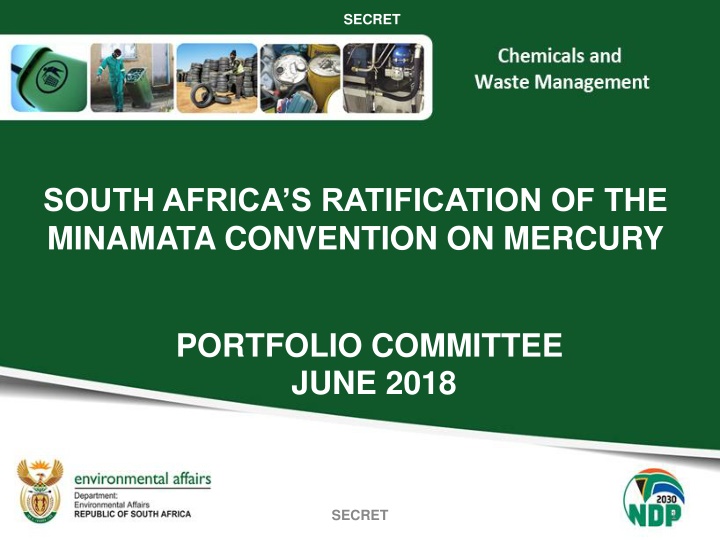


![[PDF⚡READ❤ONLINE] Planet Mercury: From Pale Pink Dot to Dynamic World (Springer](/thumb/21549/pdf-read-online-planet-mercury-from-pale-pink-dot-to-dynamic-world-springer.jpg)




